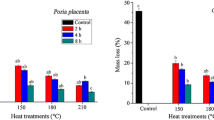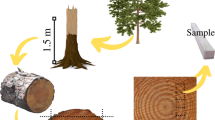Abstract
Pinus massoniana L. was thermally treated with low melting point alloy as heating medium to investigate the strength properties changes. Contact angle, color and scanning electron microscopy were recorded to assess the effectiveness of the treatment. Samples were pre-treated in a micro-wave for 5 min followed by metal bath heat treatment at 150, 180, and 210 °C for 2, 4, and 8 h, respectively. Strength properties of metal bath treated wood were decreased with increase temperature and time. Density, modulus of rupture, impact bending, modulus of elasticity were reduced for all treatments. Maximum compressive strength slightly increased at 150 °C for 4 h followed by gradual reduction. The Janka hardness was reduced in the tangential and radial directions. Treatment of the wood at 210 °C for 8 h caused the wood to become brittle and rupture. The contact angle was considerably higher after thermal treatment. The color of the wood became darker with increasing temperature of thermal treatment. Micrographs of the heat-treated samples showed damage to the cell wall with increase in temperature. Metal bath heat treatment of wood was carried out successfully and some strength properties were reduced.





Similar content being viewed by others
References
Akguuml M (2012) The effect of heat treatment on some chemical properties and colour in Scots pine and Uludağ fir wood. Int J Phy Sci 7(21):2854–2859
ASTM D 2395-14 (1991) Standard test methods for density and specific gravity (relative density) of plastics by displacement. American Society of testing and Materials, West Conshohocken
Aytin A, Korkut S (2016) Effect of thermal treatment on the swelling and surface roughness of common alder and wych elm wood. J For Res 27(1):225–229
Bekhta P, Niemz P (2003) Effect of high temperature on the change in color, dimensional stability and mechanical properties of spruce wood. Holzforschung 57:539–546
Boonstra M (2008) A two-stage thermal modification of wood. Ph.D Dissertation, Ghent University
Boonstra MJ, Tjeerdsma B (2000) Chemical analysis of heat treated softwoods. Holz Roh Werkstoff 64:204–211
Boonstra MJ, Van Acker J, Tjeerdsma BF, Kegel EV (2007) Strength properties of thermally modified softwoods and its relation to polymeric structural wood constituents. Ann For Sci 64:679–690
Candelier K, Dumarçay S, Pétrissans A, Gérardin P, Pétrissans M (2013) Comparison of mechanical properties of heat treated beech wood cured under nitrogen or vacuum. Poly Degrad Stab 98(9):1762–1765
Dubey MK, Pang S, Walker J (2012) Oil uptake by wood during heat-treatment and post-treatment cooling, and effects on wood dimensional stability. Eur J Wood Prod 70(1–3):183–190
Esteves B, Marques AV, Domingos I, Pereira H (2007) Influence of steam heating on the properties of pine (Pinus pinaster) and eucalypt (Eucalyptus globulus) wood. Wood Sci Technol 41:193–207
Esteves B, Domingos I, Pereira H (2008) Pine wood modification by heat treatment in air. BioResources 3(1):142–154
GB/T 1935-2009 (2009) Method of testing in compressive strenght parallel to grain of wood. Chinese National Standard, The People’s Republic of China
GB/T 1936.1-2009 (2009) Method of testing in bending srength of wood. Chinese National Standard, The People’s Republic of China
GB/T 1936.2-2009 (2009) Method for determination of the modulus of elasticity in static. Chinese National Standard, The People’s Republic of China
GB/T 1940- 2009 (2009) Method of testing in toughness of wood. Chinese National Standard, The People’s Republic of China
GB/T 1941-2009 (2009) Method of testing in hardness of wood. Chinese National Standard. Chinese National Standard, The People’s Republic of China
Hill CA (2007) Wood modification: chemical, thermal and other processes. Wiley, Hoboken
Hillis WE (1984) High temperature and chemical effects on wood stability. Wood Sci Technol 18(4):281–293
Homan WJ, Jorissen AJ (2004) Wood modification developments. Heron 49:360–369
Homan WJ, Tjeerdsma B, Beckers E, Jorissen A (2000) Structural and other properties of modified wood. In: World conference on timber engineering. British Columbia, Canada, p 8
Hon DN-S, Minemura N (2000) Color and discoloration. Wood Cellul Chem 2:385–442
Huang X (2012) Study on the degradation mechanism of heat-treated. Doctoral dissertation, University of Quebec at Chicoutimi
Johansson D, Morén T (2006) The potential of colour measurement for strength prediction of thermally treated wood. Holz Roh werkstoff 64:104–110
Kamperidou V, Barboutis I, Vasileiou V (2013) Response of colour and hygroscopic properties of Scots pine wood to thermal treatment. J For Res 24(3):571–575
Karamanoğlu M, Akyildiz MH (2013) Colour, gloss and hardness properties of heat treated wood exposed to accelerated weathering. Pro Ligno 9(4):729
Kasemsiri P, Hiziroglu S, Rimdusit S (2012) Characterization of heat treated eastern redcedar (Juniperus virginiana L.). J Mater Process Technol 212(12):1324–1330
Korkut S, Kök MS, Korkut DS, Gürleyen T (2008) The effects of heat treatment on technological properties in Red-bud maple (Acer trautvetteri Medw.) wood. Bioresour Technol 99:1538–1543
Kotilainen R (2000) Chemical changes in wood during heating at 150–260 °C. Department of Chemistry, University of Jyväskylä, Finland, p 51
Metsä-Kortelainen S, Viitanen H (2012) Wettability of sapwood and heartwood of thermally modified Norway spruce and Scots Pine. Eur J Wood Wood Prod 70:135–139
Metsä-Kortelainen S, Antikainen T, Viitaniemi P (2006) The water absorption of sapwood and heartwood of Scots pine and Norway spruce heat-treated at 170 °C, 190 °C, 210 °C and 230 °C. Holz Roh Werkstoff 64:192–197
Pétrissans A, Younsi R, Chaouch M, Gérardin P, Pétrissans M (2011) Experimental and numerical analysis of wood thermodegradation: mass loss kinetics. J Therm Anal Calorim 109:907–914
Priadi T, Hiziroglu S (2013) Characterization of heat treated wood species. Mater Des 49:575–582
Rusche H (1973) Thermal-degradation of wood at temperatures up to 200 °C. 1. strength properties of dried wood after heat-treatment. Holz Roh Werkstoff 31:273–281
R Development Core Team (2014) R: a language and environment for statistical computing. R Foundation for Statistical Computing, Vienna, Austria. http://www.R-project.org/
Salca EA, Hiziroglu S (2014) Evaluation of hardness and surface quality of different wood species as function of heat treatment. Mater Des 62(10):416–423
Scheiding W, Kruse K, Plaschkies K, Weiß B (2005) Thermally modified wood for playground toys: investigations on 13 industrially manufactured products
Sevim Korkut D, Guller B (2008) The effects of heat treatment on physical properties and surface roughness of red-bud maple (Acer trautvetteri Medw.) wood. Bioresour Technol 99:2846–2851
Shangguan W, Gong Y, Zhao R, Ren H (2016) Effects of heat treatment on the properties of bamboo scrimber. J Wood Sci 62(5):383–391
Standfest G, Zimmer B (2008) the surface hardness of thermally treated woods. In: Poster presentation at 62nd international convention of the forest products society, pp 22–24
Sundqvist (2004) Colour changes and acid formation in wood during heating
Tjeerdsma B, Boonstra M, Militz H (1998) Thermal modification of nondurable wood species, part 2. Improved wood properties of thermally treated wood, International Research Group on Wood Pre., Document no. IRG/WP 98-40124
Tuong VM, Li J (2010) Effect of heat treatment on the change in color. BioResources 5(2):1257–1267
Unsal O, Ayrilmis N (2005) Variations in compression strength and surface roughness of heat-treated Turkish river red gum (Eucalyptus camaldulensis) wood. J Wood Sci 51:405–409
Wahab R (2004) Strength and durability of bamboo treated through an oil-curingprocess. J Biol Sci
Wikberg H, Maunu SL (2004) Characterization of thermally modified hard and softwoods by 13 C CPMAS NMR. Carbohydr Polym 58(4):461–466
Yildiz S, Gümüşkaya E (2007) the effects of thermal modification on crystalline structure of cellulose in soft and hardwood. Build Environ 42(1):62–67
Zwinkels JC (1996) Colour-measuring instruments and their calibration. Displays 16:163–171
Author information
Authors and Affiliations
Corresponding author
Additional information
Project funding: This work was financially supported by the Special Scientific Research Fund for Public Service Sectors of Forestry (Grant No. 201504603), Science and Technology Projects of Fujian Province (2014NZ003), and the National Natural Science Foundation of China (Grant Nos. 31370560, 31170520).
The online version is available at www.springerlink.com
Corresponding editor: Yu Lei.
Rights and permissions
About this article
Cite this article
Okon, K.E., Lin, F., Chen, Y. et al. Tin-based metal bath heat treatment: an efficient and recyclable green approach for Pinus massoniana wood modification. J. For. Res. 29, 1807–1814 (2018). https://doi.org/10.1007/s11676-017-0573-6
Received:
Accepted:
Published:
Issue Date:
DOI: https://doi.org/10.1007/s11676-017-0573-6




